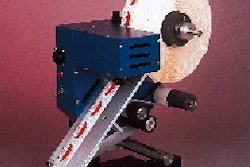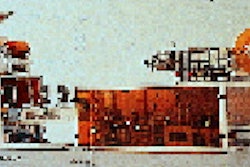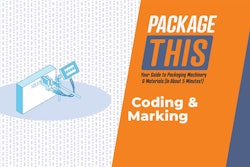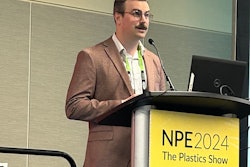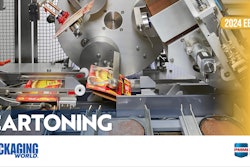Regardless of how large your sales as a manufacturer, in some cases the retailer is now calling the shots in packaging, so representatives of three major manufacturers admitted at the Management Leadership Conference of the Flexible Packaging Assn., held in Chicago in late September. FPA president Glenn Braswell moderated an end-user panel discussion that included purchasing executives from Lipton, M&M Mars and Procter & Gamble. "In our end of the business, a big buzzword is category management," says Bruce Belowich, director of packaging development at Thomas J. Lipton Co., Englewood Cliffs, NJ. "We have to work real closely with the grocery trade, and the way we manage our supply chain. So we need materials coming in almost on the day we make the product. By the next day, it's on a truck going to our customers. So ECR [Efficient Consumer Response, a grocery trade initiative] is very important to us." All that sounds good, but the ultimate question is who holds the trumps-the retailer or the consumer? According to Mark Walsh of M&M Mars, Hackettstown, NJ, there isn't much difference. "The major mass merchandisers are very efficient and very knowledgeable," he says. "They won't put a product or package on their shelves that won't move." Walsh acknowledges that retailer demands, especially for differentiated products, can cause some significant production problems for high-volume manufacturers like M&M Mars. "But at the end of the day," Walsh says, "the consumer is boss." Changing values The effect of mass merchandisers was made crystal clear by Belowich when he compared his primary customer list of a few years ago with that of today. "As recently as five years ago, our biggest grocery customers would be people like Safeway, Kroger and A&P. Today, our single biggest customer in the U.S. is Wal-Mart, a company that wasn't known as a food merchandiser until the last few years. This really demonstrates the power of the mass merchandiser. And all of them-and we include Kmart, Target and others-want a special pack exclusive to them." Today even supermarkets want special packs, he says. "It's really a challenge on our part to try to satisfy all these trade factors without terribly complicating our systems and adding too much cost to our processes." Often special packs come with requests for special displays. "Retailers don't often know the specifics of prebuilt displays until about 12 weeks before they want it delivered," notes Norma McDonald of Procter & Gamble's procurement department in Cincinnati. M&M Mars' Walsh objected, questioning that any chain would give P&G a full 12 weeks to prepare end-aisle displays. "I know we have to be faster than that," he stated. McDonald noted that an earlier speaker pointed out how few new products survive more than two years. "That substantiates the view that the consumer has the ultimate say," she says. "The requirements that the retailer imposes, and the objections they raise with a new package format are constraints. But constraints can be overcome with good problem-solving. If a product flies off the shelves, retailers will find a way to keep that product." "Demands by retailers for differentiated products do cause some considerations in our lines," Walsh states. "We're trying to balance what the [retailer] wants so far as pack proliferation goes with what we're able to produce," he adds. "Often we find through the process that we can reach an accommodation that will fulfill our customers' needs without it being a huge burden on our production process. For example, we'll try to make a bag longer rather than having to change to a wider film width. That way, we simplify our changeover and we don't have to manage a whole new inventory through the supply chain. "The demand for more SKUs has definitely come from the customers, not necessarily from the consumer," he adds. Can simplification fit? How can a manufacturer reconcile the marketplace demand for special packs with corporate strategies of package simplification? That was a question put to the panel by a converter who had read about P&G's efforts to simplify its offerings. "That is the quandary, isn't it?" McDonald responded. "We make each of our choices on simplification based on business drivers. Obviously, if you're going to drive down sales volume by cutting back on the number of sizes offered, that's not a smart choice." Occasionally, though, the two goals are not mutually exclusive. McDonald recounted how P&G switched to a single cap color for Mr. Clean products without any negative response. "We used to have six different cap colors on these products. This cost us extra money in purchasing, plus it was a source of reliability headaches on our packaging line," she said. Belowich acknowledges the challenge of retailer demands vs package simplification. "There has to be a balance between satisfying our customer and not walking away from the business potential of these big accounts. In the food business, [mass merchandisers] have become really enormous." He acknowledges that Lipton tries to meet the marketplace needs "without adding too much cost" to its operation. Walsh of M&M Mars says the confections side of his company's business isn't markedly affected by pack proliferation demands from retailers. On the pet food side, though, he says, there is customer "encouragement" for weather-proof packaging and more product protection. Yet, he says, any new package has to occupy the same footprint as the former package. How about added services? The manufacturers were asked by FPA's Braswell about the value of added services offered by converters with their products. Walsh of M&M Mars didn't equivocate in his answer. "It's hard to put a value on these services, except to say that, without them, your product won't be accepted," Walsh stated. "The pipeline has to become more efficient all the way up and down the supply chain. Converters have to be the bridge between the resin and film companies to end users like us." Lipton's Belowich agreed, saying, "We're into packaging partnerships with several companies, [even though] we know we can buy materials cheaper. We know we're paying for the added services, but we feel they're important for the way we do business. Technical support is important to us." What converters can do that would be valuable to P&G is help in managing artwork changes and assist in dealing with size proliferation, Norma McDonald pointed out. "As our products mature, people want to buy those products in larger sizes, making a larger investment in products they've tried. Vendors can help us move to that larger size." Future for flexibles? There was good news for converters from both Walsh and Belowich. Obviously, M&M Mars' confections have long been in flexible overwraps and form/fill/seal pouches. And Belowich noted that consumers like flexible pouches for Lipton products like pasta and sauces. He did note that reclosability is an issue that converters need to address for multi-use packs like cereal and cookie bags. P&G's Norma McDonald was less encouraging, but not because of the materials. P&G finds it difficult to justify the equipment costs when it looks to replace a rigid pack with a flexible one. "Our biggest constraint is the form/fill/seal machinery," she stated candidly. "What drives up the cost of flexible packaging is the cost of equipment. When you're used to filling bottles or jars at high speeds, a pouch is a radical change." A bottling line that runs at 300/min can be purchased for $500ꯠ to $1 million. To produce 300 pouches/min would require several f/f/s machines that would cost twice that or more, McDonald estimated. "The machines have to get their speeds up. They've got to approach 75 percent of the rigid packaging output to be feasible." She says P&G analyzed the costs of switching to flexible packaging for 20 of its products. "The substitution simply didn't make economic sense."


